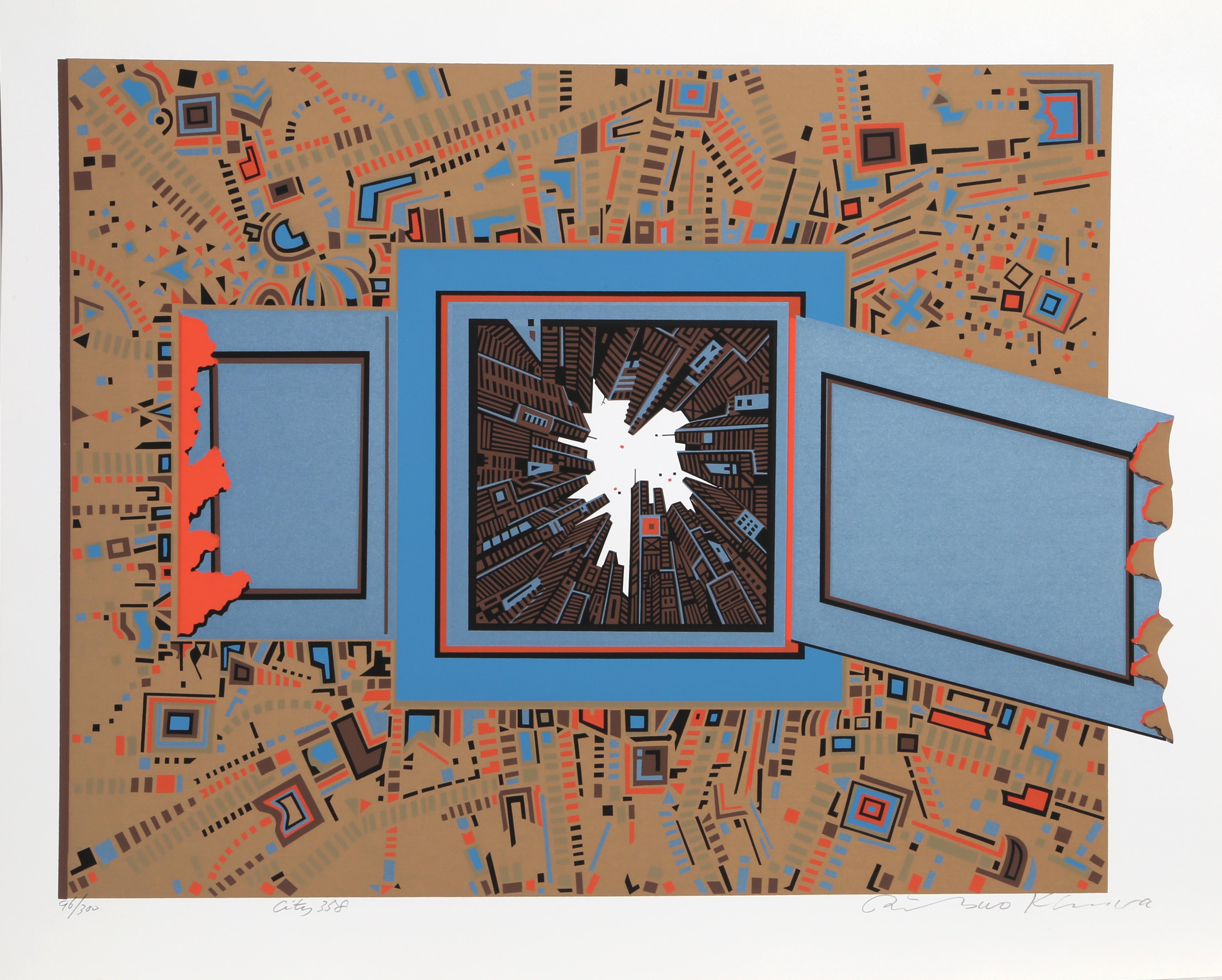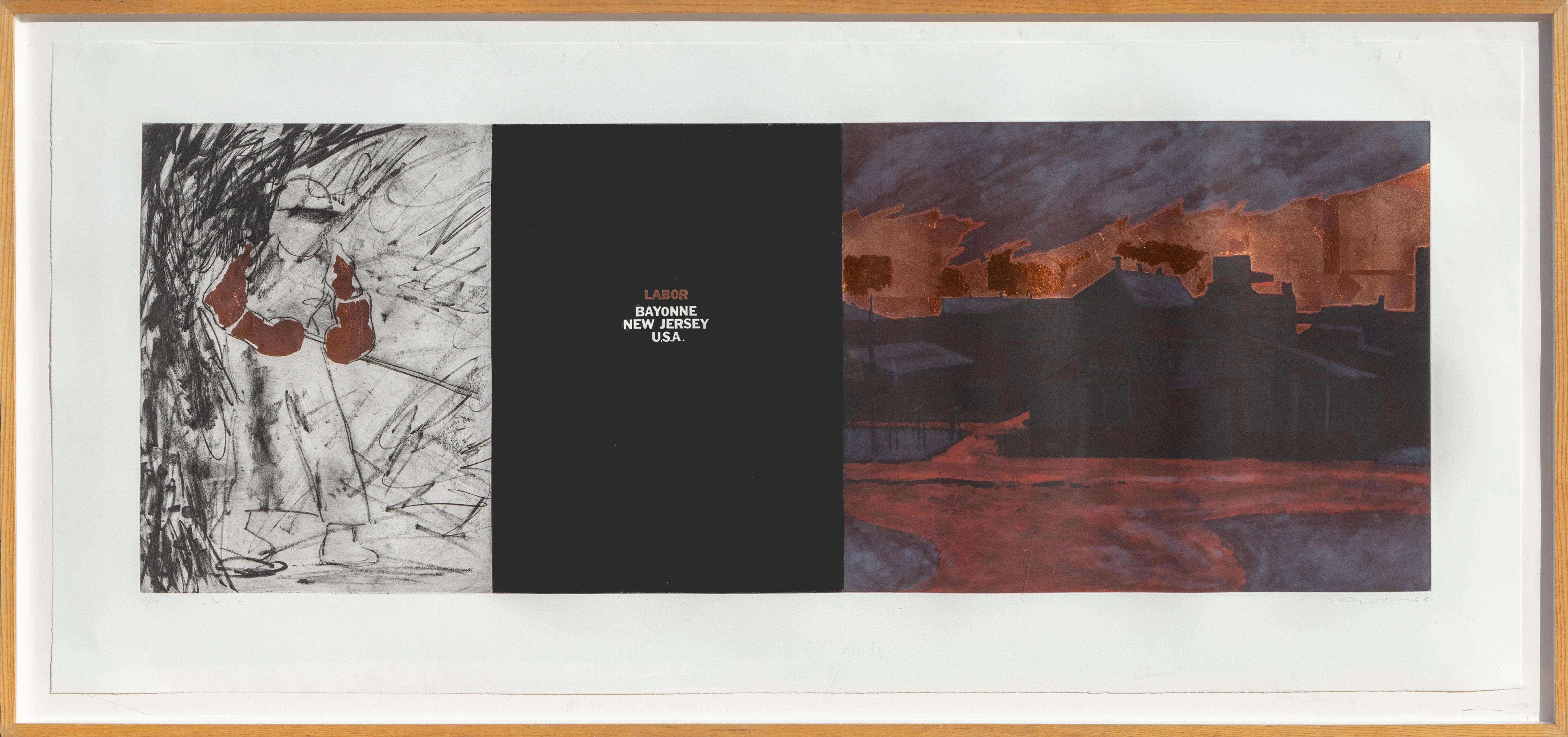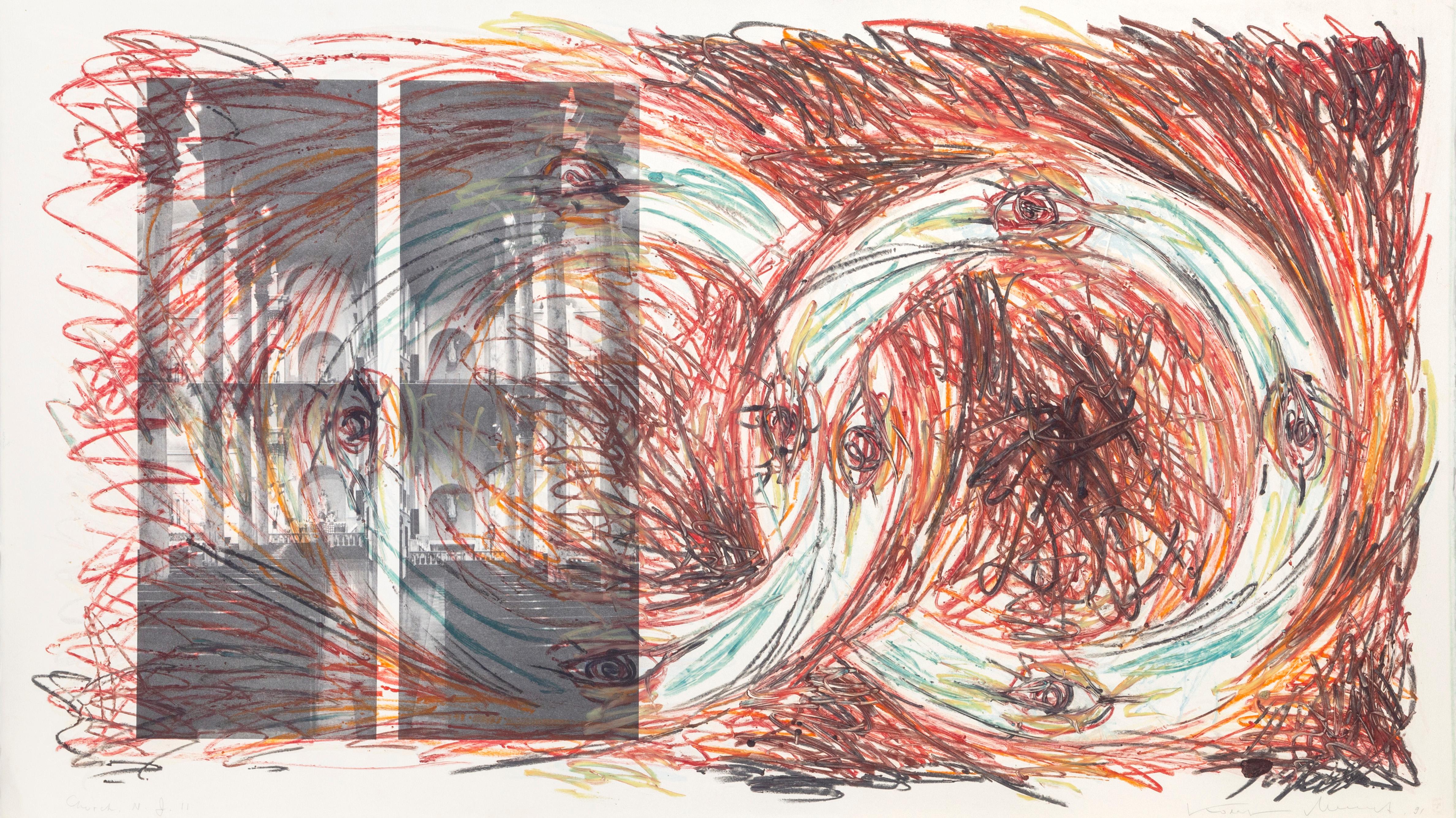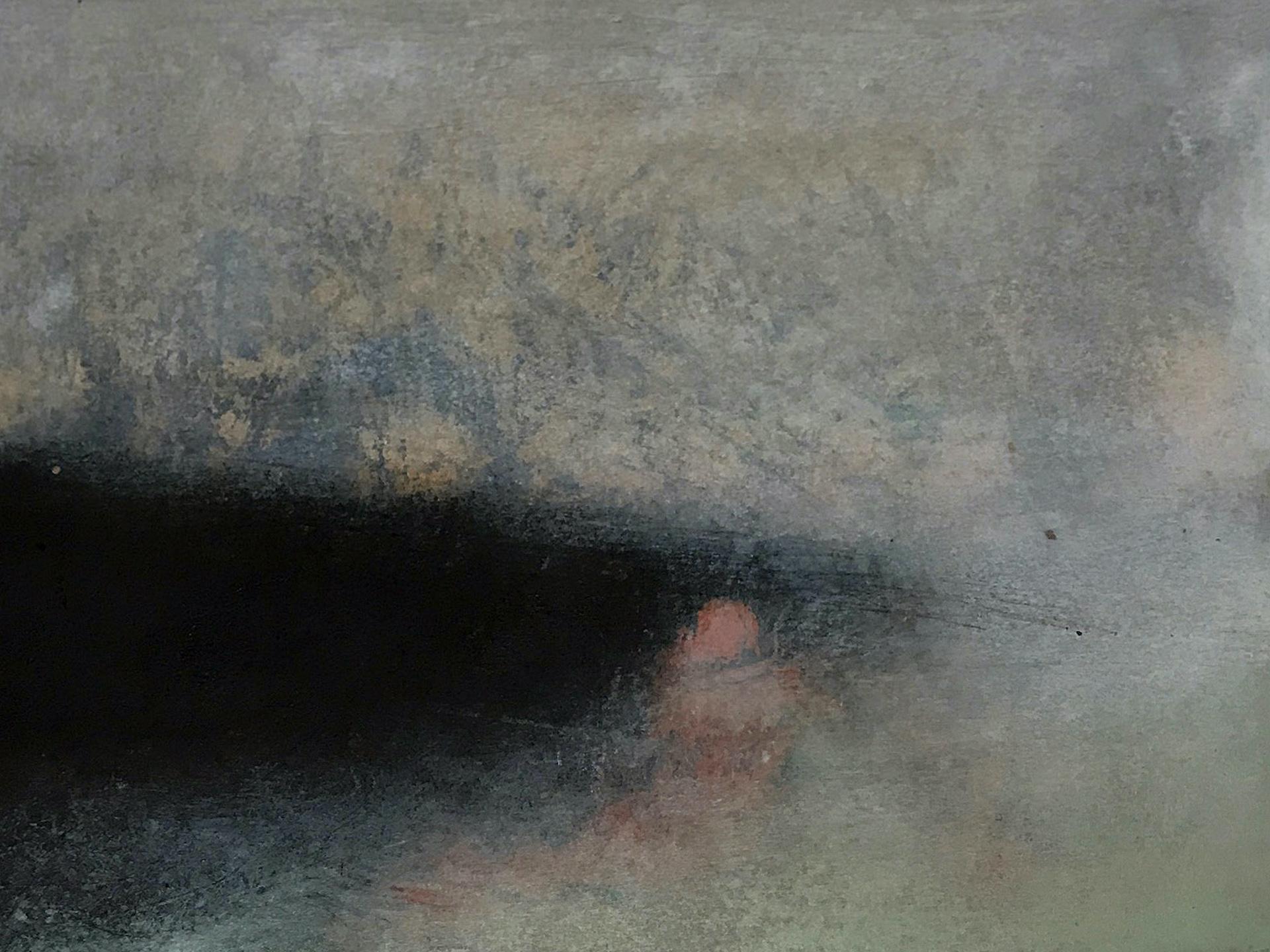Items Similar to Stars Missoula Montana by top conceptual artist signed, numbered Large: 41 x 30"
Want more images or videos?
Request additional images or videos from the seller
1 of 6
Dennis OppenheimStars Missoula Montana by top conceptual artist signed, numbered Large: 41 x 30"1979
1979
About the Item
Dennis Oppenheim
Stars Missoula Montana, 1979
Lithograph on Arches cover paper
Hand signed and dated on the front, Edition 81/150
41 × 30 inches
(ships rolled in a tube measuring 35 x 5 x 5)
Unframed
Pencil signed and numbered from the limited edition of 150 by pioneering environmental/conceptual/earth artist Dennis Oppenheim.
Dennis Oppenheim
American pioneer of Land art and Body art, born in Mason City, Washington. Studied at California College of Arts and Crafts, and Stanford University. Impressed by Kienholz, but reacted against his work c.1965. After a visit to New York 1966-7, decided to abandon making objects. Settled in New York in 1967. From mid 1967 to 1969, concerned with increasingly large-scale earth-orientated projects, including the inscribing or transplanting of lines or material associated with one site onto a second site strikingly different from it, e.g. the tracing in snow on either side of the St John River, the frontier between Canada and the USA, of concentric circles corresponding to the annular rings of a tree. First one-man exhibition in New York, of Ground Systems, at the John Gibson Gallery 1968. Began in 1969 to use his own body as material by subjecting it to wounds, pressures, sunburn etc., sometimes as an investigation of biological processes. He moved to New York in 1966 where he first taught nursery school and then high school art while working toward his first one-person exhibition in New York, held in 1968 when he was 30 years old. Oppenheim's early work tended to focus on human and animal performances. In the early 1970s, he was in the vanguard of artists using film and video in relation to performance. In a series of works produced between 1970 and 1974, Oppenheim used his own body as a site to challenge the self: he explored the boundaries of personal risk, transformation, and communication. 1981 opened a new chapter, with machine pieces, complex constructions which he used to create a metaphor for the artistic process. By the mid-eighties his sculpture was based on the transformation of everyday objects. Since the mid-ninties his work has become larger in scale and permanent, fusing sculpture and architecture.He was included in both the Venice Biennale and the Johannesburg Biennale in 1997. He lived and worked in New York City.
- Creator:Dennis Oppenheim
- Creation Year:1979
- Dimensions:Height: 35 in (88.9 cm)Diameter: 5 in (12.7 cm)
- Medium:
- Movement & Style:
- Period:
- Condition:
- Gallery Location:New York, NY
- Reference Number:1stDibs: LU1745214303072
About the Seller
5.0
Platinum Seller
These expertly vetted sellers are 1stDibs' most experienced sellers and are rated highest by our customers.
Established in 2007
1stDibs seller since 2022
289 sales on 1stDibs
Typical response time: 1 hour
- ShippingRetrieving quote...Ships From: New York, NY
- Return PolicyA return for this item may be initiated within 1 day of delivery.
More From This SellerView All
- Yvon Lambert Gallery Poster (Hand Signed and Addressed by Dennis Oppenheim)By Dennis A. OppenheimLocated in New York, NYDennis Oppenheim Directed Seeding -Wheat, Historic Yvon Lambert Gallery Poster (Hand Signed and Addressed by Dennis Oppenheim), 1969 Offset lithograph poster. Hand signed, inscribed. Postmarked and addressed to Oppenheim's dealer, John Gibson 23 × 16 inches Hand Signed and inscribed by Dennis Oppenheim lower right in blue marker in 2006, hand addressed by Dennis Oppenheim in 1969 in red marker Unframed This is an extremely uncommon vintage poster/mailer announcing the May 20th, 1969 opening reception (Vernissage) for the exhibition of works by American conceptual art pioneer Dennis Oppenheim at the Yvon Lambert Gallery in Paris. The poster is historic in that it was originally mailed to John Gibson, the East 67th Street dealer, who famously gave Dennis Oppenheim his first New York exhibition in 1968, and it is hand addressed to Gibson, bearing the original Paris, France postmark of 1969. It is, exceptionally, hand signed and dedicated by Dennis Oppenheim to a collector who acquired the poster from John Gibson's collection, and then secured Dennis Oppenheim's autograph in 2006, making this an especially valuable collectors item. More information about the project from the Tate Gallery archives, which acquired the work: This work brings together two interventions Oppenheim created on a field owned by farmer Albert Waalken in Finsterwolde, north-eastern Holland, in 1969. It comprises four distinct elements mounted on board: a colour photograph of a wheatfield being sowed by a tractor in parallel curving lines seen from high up; a negative image in black and white of a map of the area of Finsterwolde onto which two sections of text have been collaged; and two black and white aerial photographs of the same field being traversed by a tractor cutting an X into the wheat. The first two elements relate to the action Directed Seeding. For this the field was seeded according to a line plotted by following the road from the village of Finsterwolde, the location of the field, to Nieuweschans, another village where the farmer’s storage silo for wheat was located. Oppenheim reduced this curved line by a factor of six in order to direct the trajectory of seeding. The tractor then carved a series of curved parallel lines on the surface of the field as it dug up earth and scattered seed. From an aerial perspective the patterning of parallel lines may be viewed as a form of line drawing on the landscape. The precise location of the field and the silo are indicated on the map, showing the trajectory of the road. The two sections of text collaged onto the upper portion of the map briefly describe the two interventions. Explaining the action Cancelled Crop, the artist wrote: In September the field was harvested in the form of an X. The grain was isolated in its raw state, further processing was withheld. This project poses an interaction upon media during the early stages of processing. Planting and cultivating my own material is like mining ones own pigment (for paint) – I can direct the later stages of development at will. In this case the material is planted and cultivated for the sole purpose of withholding it from a product-oriented system. Isolating this grain from further processing (production of food stuffs) becomes like stopping raw pigment from becoming an illusionistic force on canvas. The esthetic is in the raw material prior to refinement, and since no organization is imposed through refinement, the material’s destiny is bred with its origin. (Quoted from artist’s statement in Tate acquisition file.) Directed Seeding and Cancelled Crop are two separate works, brought together in several different versions of which Tate’s is one. The collage presents three ways in which human action may marks the land. For the first two, agricultural machinery is used to create straight lines, in the process of harvesting as in the X of Cancelled Crop, or curved lines, during the process of planting seed in the contours photographed for Directed Seeding. The map shows a third (and more ancient) way of marking the land, through the construction of roads. The use of the landscape – natural, industrial or urban – as a canvas on which to act is typical of Oppenheim’s work in the late 1960s and early 1970s. In a related action, Directed Harvest, 1966 (Tate T07590) and Directed Harvest 1968 (Kröller-Müller Museum, Otterlo, Netherlands), the artist caused a field to be harvested in linear patterns which he then had photographed in its progressive stages. In Reverse Processing: Cement Transplant, East River, NY, 1970, 1978 (Tate T07591) Oppenheim drew large crosses on the roofs of barges transporting raw cement that he found moored on the New York East River banks. All these works centre on process as an agent of change and utilise materials, elements and locations on which the artist can have no permanent claim, making them deliberately ephemeral. Such actions as seeding a crop and harvesting it several months later operate within time parameters dependent on the cycles of the seasons rather than the will of man, mixing human processes with those of nature. Oppenheim’s analogy between the prevention of a crop from entering the food chain and the halting of the expressive, ‘illusionistic’ force of paint deconstructs the sophisticated processes of art-making and the food industry to the elemental notion of making simple marks on the environment. In this way, the artist highlights contemporary man’s dependency on complex chains...Category
1960s Conceptual Landscape Prints
MaterialsOffset
- Fagends Carved in Rock, De-Accessioned from the Denver Art MuseumBy Claes OldenburgLocated in New York, NYClaes Oldenburg Fagends Carved in Rock, De-Accessioned from the Denver Art Museum (137, Axsom and Platzker), 1975 Offset Lithograph. Hand signed and numbere...Category
1970s Pop Art Abstract Prints
MaterialsOffset, Graphite, Lithograph
- El Santuario de Chimayó, large lithograph, signed, numbered 1/40 renowned artistBy Gregory AmenoffLocated in New York, NYGREGORY AMENOFF El Santuario de Chimayó, 1986 Lithograph in Colors on wove paper 37 × 38 inches Edition 1/40 Hand Signed, titled, dated, and numbered in pencil 1 from the edition of only 40 lower margin front Unframed A stunning richly colored lithograph by this important artist...Category
1880s Abstract Expressionist Abstract Prints
MaterialsLithograph, Pencil
- Remember the Sabbath Day (The Fourth Commandment)By April GornikLocated in New York, NYApril Gornik Remember the Sabbath Day (The Fourth Commandment), 1987 2 Color Lithograph on Dieu Donne handmade paper with deckled edges 24 × 18 inches Signed and numbered AP 12/15, a...Category
1980s Naturalistic Landscape Prints
MaterialsLithograph, Pencil, Graphite
- Steven's Carnage, from the Art Against AIDS Portfolio, Signed/N Lithograph 38/50Located in New York, NYMalinda Beeman Steven's Carnage, from the Art Against AIDS Portfolio, 1988 Lithograph on paper with deckled edges. Hand signed. Numbered. Titled. Printer's and Publisher's Blind Stam...Category
1980s Contemporary Abstract Prints
MaterialsPencil, Lithograph
- L:os Angeles Bicentennial: 200 Years Old (hand signed & numbered by Ed Ruscha)By Ed RuschaLocated in New York, NYEd Ruscha 200 Years Old, 1980 Offset lithograph Hand signed and numbered 132/425 by Ed Ruscha in graphite pencil on the front 30 1/2 × 25 inches Unframed This is a quintessential Los Angeles print...Category
1980s Pop Art Landscape Prints
MaterialsLithograph, Offset, Pencil, Graphite
You May Also Like
- City 358, Geometric Serigraph by Risaburo KimuraBy Risaburo KimuraLocated in Long Island City, NYArtist: Risaburo Kimura, Japanese (1924 - ) Title: City 358 Year: 1971 Medium: Serigraph, signed and numbered in pencil Edition: 300 Size: 23 x 28 in. (58.42 x 71.12 cm)Category
1970s Conceptual Landscape Prints
MaterialsScreen
- Sunrise at Bayonne, Framed Conceptual Aquatint Etching by Komar & MelamidBy Komar & MelamidLocated in Long Island City, NYArtist: Vitaly Komar, Russian (1943 - ) and Alexander Melamid, Russian (1945 - ) Title: Sunrise at Bayonne Year: 1988 Medium: Aquatint Etching with Metallic Leaf Collage, signed and ...Category
1980s Conceptual Landscape Prints
MaterialsEtching, Aquatint
- Church, NJ, Abstract Aquatint Etching by Komar & MelamidBy Komar & MelamidLocated in Long Island City, NYArtist: Vitaly Komar, Russian (1943 - ) and Alexander Melamid, Russian (1945 - ) Title: Church, NJ Year: 1991 Medium: Etching, signed, numbered, dated, and tilted in pencil Paper Si...Category
1980s Conceptual Landscape Prints
MaterialsEtching, Aquatint
- Tim Southall, Destination Unknown, Contemporary Art Print, Affordable ArtBy Tim SouthallLocated in Deddington, GBTim Southall Destination Unknown Limited Edition Print Edition of 45 Image Size: H 15cm x W 20cm Sheet Size: H 26cm x W 32cm x D 0.1cm Sold Unframed Pleas...Category
21st Century and Contemporary Conceptual Abstract Prints
MaterialsPaper, Etching, Monoprint
- Woodland Skyscape 142, Forest Sky, Trees, Lapis Navy Blue, Light Yellow, TealBy Eve StocktonLocated in Kent, CTThis square woodcut print on paper evokes the peacefulness of looking upwards through a forest canopy in a symmetrical pattern composed of the silhouettes of trees in shades of dark ...Category
2010s Contemporary Landscape Prints
MaterialsArchival Ink, Archival Paper, Color Pencil, Monoprint, Woodcut
- Woodland Skyscape 45, Woodcut Print of Forest Canopy and Sky, Violet, Blue, CyanBy Eve StocktonLocated in Kent, CTThis woodcut print on paper is a peaceful view through a forest canopy. The symmetrical composition of trees is shades of dark blue and cobalt blue. The monotype brings to mind the t...Category
2010s Contemporary Landscape Prints
MaterialsArchival Ink, Archival Paper, Color Pencil, Monoprint, Woodcut





